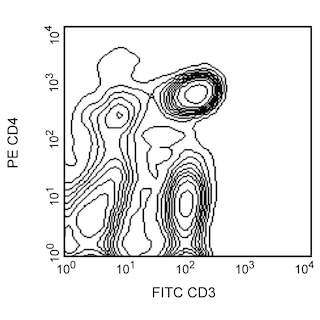-
Your selected country is
Middle East / Africa
- Change country/language
Old Browser
This page has been recently translated and is available in French now.
Looks like you're visiting us from {countryName}.
Would you like to stay on the current country site or be switched to your country?




Flow cytometric analysis of CD25 expression on unstimulated and stimulated rat splenocytes. Left and Middle Plots: Freshly-prepared, unstimulated rat splenic leucocytes were preincubated with Purified Mouse Anti-Rat CD32 antibody (Rat BD Fc Block™) (Cat. No. 550270/550271). The cells were then stained with PE Mouse Anti-Rat CD4 antibody (Cat. No. 554838) and either BD Horizon™ BV421 Mouse IgG1, κ Isotype Control (Cat. No. 562438; Left Plot) or BD Horizon BV421 Mouse Anti-Rat CD25 antibody (Cat. No. 565608; Middle Plot). Two-color flow cytometric dot plots showing the correlated expression pattern of CD25 (or Ig Isotype control staining) versus CD4 were derived from gated events with the forward and side light-scatter characteristics of viable splenocytes. Right Plot: Rat splenic leucocytes were stimulated for 3 days with concanavalin A. The cells were preincubated with Purified Mouse Anti-Rat CD32 antibody (Rat BD Fc Block™) and then stained with either BD Horizon BV421 Mouse IgG1, κ Isotype Control (dashed line histogram) or BD Horizon BV421 Mouse Anti-Rat CD25 antibody (solid line histogram). The normalized fluorescence histograms showing CD25 expression (or Ig Isotype control staining) were derived from gated events with the forward and side light-scatter characteristics of viable lymphoblasts. Flow cytometric analysis was performed using a BD LSRFortessa™ Cell Analyzer System.


BD Horizon™ BV421 Mouse Anti-Rat CD25

Regulatory Status Legend
Any use of products other than the permitted use without the express written authorization of Becton, Dickinson and Company is strictly prohibited.
Preparation And Storage
Recommended Assay Procedures
For optimal and reproducible results, BD Horizon Brilliant™ Stain Buffer should be used anytime BD Horizon Brilliant™ dyes are used in a multicolor flow cytometry panel. Fluorescent dye interactions may cause staining artifacts which may affect data interpretation. The BD Horizon Brilliant Stain Buffer was designed to minimize these interactions. When BD Horizon Brilliant Stain Buffer is used in in the multicolor panel, it should also be used in the corresponding compensation controls for all dyes to achieve the most accurate compensation. For the most accurate compensation, compensation controls created with either cells or beads should be exposed to BD Horizon Brilliant Stain Buffer for the same length of time as the corresponding multicolor panel. More information can be found in the Technical Data Sheet of the BD Horizon Brilliant Stain Buffer (Cat. No. 563794/566349) or the BD Horizon Brilliant Stain Buffer Plus (Cat. No. 566385).
Product Notices
- Since applications vary, each investigator should titrate the reagent to obtain optimal results.
- Please refer to www.bdbiosciences.com/us/s/resources for technical protocols.
- Caution: Sodium azide yields highly toxic hydrazoic acid under acidic conditions. Dilute azide compounds in running water before discarding to avoid accumulation of potentially explosive deposits in plumbing.
- For fluorochrome spectra and suitable instrument settings, please refer to our Multicolor Flow Cytometry web page at www.bdbiosciences.com/colors.
- Pacific Blue™ is a trademark of Molecular Probes, Inc., Eugene, OR.
- An isotype control should be used at the same concentration as the antibody of interest.
- Source of all serum proteins is from USDA inspected abattoirs located in the United States.
Companion Products






The OX-39 monoclonal antibody specifically binds to the α chain of the IL-2 Receptor (IL-2Rα, IL2RA) on activated T cells, T regulatory cells, and thymic and splenic dendritic cells. CD25 has also been detected on rat intestinal epithelial cells. It has been reported that OX-39 mAb weakly blocks binding of IL-2 to T-cell blasts and that it blocks IL-2 stimulated epithelial cell migration in an in vitro model of wound healing.

Development References (5)
-
Dignass AU, Podolsky DK. Interleukin 2 modulates intestinal epithelial cell function in vitro. Exp Cell Res. 1996; 225(2):422-429. (Clone-specific: Blocking). View Reference
-
Hillebrands JL, Whalen B, Visser JT, et al. A regulatory CD4+ T cell subset in the BB rat model of autoimmune diabetes expresses neither CD25 nor Foxp3.. J Immunol. 2006; 177(11):7820-32. (Clone-specific: Cell separation, Flow cytometry, Fluorescence activated cell sorting). View Reference
-
Josien R, Heslan M, Soulillou JP, Cuturi MC. Rat spleen dendritic cells express natural killer cell receptor protein 1 (NKR-P1) and have cytotoxic activity to select targets via a Ca2+-dependent mechanism. J Exp Med. 1997; 186(3):467-472. (Clone-specific). View Reference
-
Paterson DJ, Jefferies WA, Green JR. Antigens of activated rat T lymphocytes including a molecule of 50,000 Mr detected only on CD4 positive T blasts. Mol Immunol. 1987; 24(12):1281-1290. (Immunogen: Blocking). View Reference
-
Tellides G, Dallman MJ, Kupiec-Weglinski JW, Diamantstein T, Morris PJ. Functional blocking of the interleukin-2 receptor (IL-2R) may be important in the efficacy of IL-2R antibody therapy. Transplant Proc. 1987; 19(5):4231-4233. (Clone-specific: Blocking). View Reference
Please refer to Support Documents for Quality Certificates
Global - Refer to manufacturer's instructions for use and related User Manuals and Technical data sheets before using this products as described
Comparisons, where applicable, are made against older BD Technology, manual methods or are general performance claims. Comparisons are not made against non-BD technologies, unless otherwise noted.
For Research Use Only. Not for use in diagnostic or therapeutic procedures.
Report a Site Issue
This form is intended to help us improve our website experience. For other support, please visit our Contact Us page.